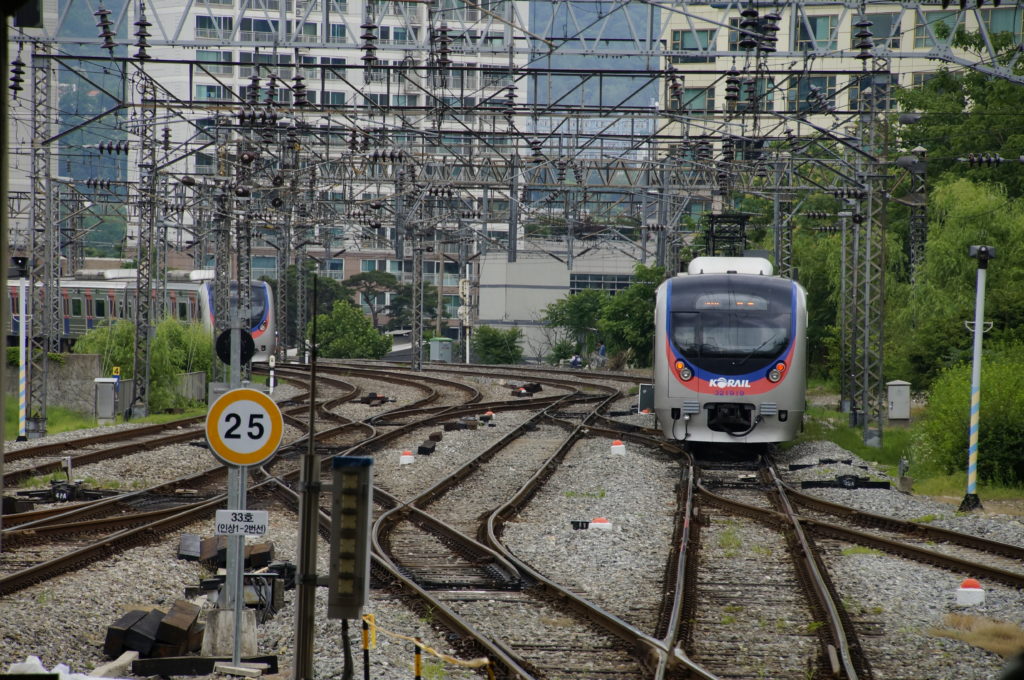The Peninsula
Building the Seoul Metro System, Part 1: Steel
Published November 25, 2019
Category: South Korea

By Rachel Kirsch
The Seoul Metropolitan Subway is often considered one of the best in the world. From trains that routinely arrive on time to cars enabled with Wi-Fi, the Seoul metro provides riders with a positive experience and short travel times. This near-optimal metro system was not built by accident. It was the result of Seoul’s focus on three distinct aspects of the public transportation system. This is the first in a three-part series focusing on the development of the Seoul metro system. See also Part 2: Plastic and Part 3: Silicon
Foremost, the government made an early commitment to building an extensive network of tracks. The present-day metro has tracks reaching almost every part of Seoul, with 30% of the population living within walking distance (typically considered 800m) of a station. These tracks form the backbone of an exceptional metro system.
Origins of the Seoul Metro System
In the second half of the twentieth century, South Korea experienced economic development centered around Seoul. But as people began migrating to the city, the infrastructure failed to keep up. For instance, car ownership increased quickly, but road construction progressed much more slowly leading to serious traffic problems. Consequently, expanding the fleet of public buses was an insufficient solution because of its reliance on the same overcrowded roads. In response, Seoul looked to expand their public transportation system by digging underground.
To construct and operate the new metro, the government relied on two separate public companies. The first was the Korean National Railroad, today known as Korail, which was founded in 1963 for the purpose of building railroads connecting cities around the country. The government partnered their expertise with a new company founded in 1970, the Seoul Metro Corporation, which focused on rapid transit. In 1974, the two companies worked together to open the first metro line across Seoul.
Line Construction
Phase 1 launched the metro system with the construction of Lines 1-4, which were completed in 1985. Geographically, the first phase focused on providing services to the areas that were (and continue to be) the most populated areas of the city. The five busiest stations and the three of the five biggest transfer stations in modern Seoul were all built during Phase 1. For the establishment of the system, it was important that the metro start with the places people needed to access the most.
Ten years after the completion of Phase 1, the first line of Phase 2 opened. The second phase ended in 2000 after adding four new lines and one hundred and sixty-one new stops to the system in a span of only five years. With this phase, the government adopted a different approach. Instead of continuing to concentrate on highly populated areas, the focus shifted to reaching areas of Seoul that lacked metro access. Phase 2 played an equally critical role in the evolution of the system because the diversification of track locations broadened the area and population that benefited from the metro.
A Change in Plans
Despite its early successes, the Seoul metro system began to struggle with its own mistakes and shortcomings. Seoul continued to be a popular location to live, but space within the city was limited, and due to a lack of public transportation in nearby satellite cities, people were hesitant to move to these locations. In the ten year gap between Phase 1 and 2, fifty-nine new metro stations opened, but they were all on the four pre-existing lines limiting the options for people commuting into the city. It was not until the late 2000s, when the metro began to change its strategy and introduce specialized, commuter lines to complement the pre-existing metro system. But these lines still left riders with long commutes and limited options.
The decreased budget allocated for public transportation also influenced the government’s change in policy toward rail transportation. Low funding led to the cancelation of the majority of Phase 3, except for Line 9, which did not open until 2009. Seoul had been able to build a system that covered vast portion of the city, but as time went on, the government realized that simply laying extensive rail lines was not enough to make a satisfactory metro system.
These issues would be resolved through the public transit authorities’ adoption of new systems to increase operation speed, which is addressed in Part 2: Plastic.
Conclusion
By dedicating its resources to the construction of numerous tracks, the Seoul government had great success in building a system that adequately traversed the breadth of the city. But its focus on serving the city while neglecting the outskirts hindered commuters from reaping its full benefits. However, the government continues to add commuter rail lines to fix this major vulnerability in the system. Even though the metro has faced setbacks, the first three decades of the Seoul metro provided a strong foundation for future advancements.
Rachel Kirsch is an intern at the Korea Economic Institute. Rachel graduated from Belmont University with a degree in international politics. The views expressed here are the author’s alone.
The picture is from user MTA T Train on flickr
